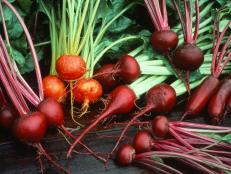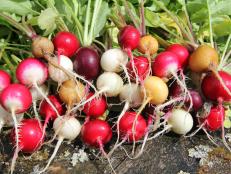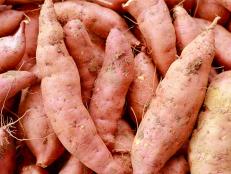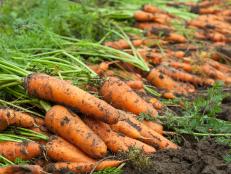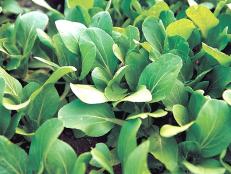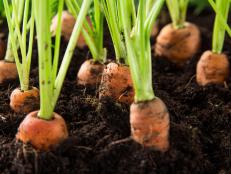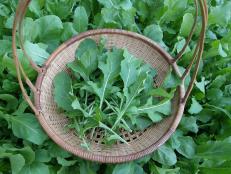Planting and Growing Turnips
Turnips are easy to grow and so delicious. Learn how to plant and grow this versatile vegetable.

Debbie Wolfe
Turnips are delicious in a variety of dishes and so easy to plant and grow, making them well worth some space in the garden.

Whether they're grown for their leafy greens or fleshy roots, turnips make an excellent addition to any vegetable garden. Turnips come up quickly from seed, are ready to harvest within two months and are productive during cool spring and fall weather when many other vegetable crops are not. These versatile vegetables are delicious in a variety of dishes and so easy to grow, making them well worth some space in the garden.
Types of Turnips
Turnips can be grown for their large, starchy roots or for their tender foliage. There are specialized varieties bred for each of these qualities. 'Alamo,' 'All Top' and 'Seven Top' are prized for their foliage, while 'Just Right Hybrid,' 'Purple Top White Globe' and 'Tokyo Cross' are a few of the varieties bred for their roots. Varieties selected for their greens may not form roots, but you can usually harvest the leaves of rooting turnips without hurting yields.
Look for varieties that are slow to bolt for spring-grown turnips or for Southern gardens. 'Topper' and 'Fuku Komachi Hybrid' are two relatively heat-tolerant selections.
Getting the Planting Site Ready
Bed Preparation
Mix plenty of well-rotted manure or compost into the garden before planting. Add a healthy dose of organic material to enhance the water-holding capacity of the soil, increase drainage for poorly drained soils and improve the environment for root development. While you're mixing in organic matter, be sure to pull out any rocks, sticks or other obstructions that might stunt root growth.
Do a Soil Test
While it's always a good idea to do a soil test before starting a vegetable garden, this is an especially important step when growing turnips. Turnips are particularly susceptible to clubroot disease, which can often be traced back to overly acidic soil. Test kits are sold at garden centers and nurseries, or your local extension service office may be able to test a soil sample for you. If your soil pH is below 6.5, follow the soil test report recommendations to make the soil less acidic. A good soil test report will also include guidance for your fertilization schedule and any other soil amendments.
Practice Crop Rotation
Turnips are closely related to other plants in the Brassicaceae family such as bok choi, broccoli, cabbage, kale and rutabagas. Brassicas are susceptible to many of the same pest and disease problems, which can build up in the soil if these relatives are grown in the same spot year after year. Group turnips with their brassicaceous relatives and grow them in a different area of the garden each season. Rotating where these crops are grown will limit pest and disease populations from building up in the soil. For best results, try to allow at least 3 years between growing brassicas again in a particular spot.
Turnip Companion Plants
Companion plants improve the health of crops by attracting beneficial insects, deterring pests and improving the soil. While there isn't much research looking specifically at companions for turnips, there are many studies on good companions for its relatives in the brassica family, like broccoli. Experiment with companion planting in your garden to find the plant combinations that work best for you. Here are a few combinations to try:
- Interplant with German chamomile or dill to discourage caterpillar pests like cabbage loopers.
- Cultivate alongside marigolds or onions to protect turnips from cabbage root flies by camouflaging your turnips with their fragrance.
- Sow a trap crop of radishes to lure flea beetles away from your turnips.
- Grow plants in the aster family, like cosmos, daisies, sunflowers and zinnias, to attract predators of turnip pests.
Turnips can be great companions to other vegetables in the garden, too. Their deep, swollen taproots can help break up compacted soils. For garden beds with especially heavy soils, look for varieties that have been bred for "biodrilling," such as 'Appin.'
Planting Turnips
When To Plant Turnips
Turnips are a cool-season crop that can tolerate cold weather. You can plant turnip seed in the garden for an early crop as soon as soil temperatures are at least 40 degrees in the spring. Sow turnip seeds between 8 and 10 weeks before your region's average first frost date for a fall crop. Turnips are grown as a winter crop in the deep South and can usually be planted from August to February.
Cultivating a spring crop of turnips can feel like a race against the weather. As summer approaches and temperatures climb, the risk of bolting (or flowering) increases. Once a turnip begins to bolt, neither the roots nor the leaves are really much good to eat anymore. On the other hand, growing fall-grown turnips can become a bit of a waiting game. Turnip roots may be ready to harvest before the first frost, but an autumn frost will sweeten the turnip's flavor.
Check with your local extension service to find out when turnips grow best in your area. If you're concerned about timing, save some space to sow a new succession of turnip seeds every few weeks.
Planting Turnips in the Garden
Turnip seeds grow best when sown directly into the garden. Use a hoe to dig a thin drill — a narrow furrow — along the length of your garden bed. For multiple rows of turnips, dig drills 12 to 18 inches apart. Gently water in the drill before planting. Allow the water to percolate into the soil for about a day before sowing seed if the soil is especially dry.
Sow seeds in the drill roughly an inch apart — for most folks, this is about the width of your thumb. Use a rake to lightly cover drills with about half an inch of soil. Keep the soil moist by gently sprinkling with water until sprouts appear. Try not to allow the soil to form a dry crust, as this can prevent tender young seedlings from emerging. Seedlings should appear within a week.
Thin seedlings to about 3 inches apart within a week or so after they sprout. Thin plants to 6 inches apart when plants grow large enough that their leaves begin to touch. Don't throw those thinned plants away — they can be used as microgreens and in salad. Be sure to water the remaining plants well after thinning plants.
Growing Turnips
Water Needs
Turnips aren't terribly demanding when it comes to water, but they do not tolerate drought. Spring-grown turnips may only need to be watered during establishment and dry spells. Turnips grown for a fall crop will need more frequent watering during hot, late summer weather. A healthy layer of mulch will conserve water as well as limit weed competition and feed the soil.
Scout for Health Issues
Pests like cabbage root fly, cabbage loopers, flea beetles, aphids, slugs and snails can all damage turnips. Floating row covers are extremely effective at protecting turnips from most pest problems, except for slugs and snails. If these pests are a problem, look for environmentally friendly ways to manage slugs and snails.
If you're growing turnip greens, cabbage loopers and other caterpillars can cause a lot of damage to the harvest. Treat your plants with Bt (Bacillus thuringiensis) to stop these caterpillars from feasting on your turnip greens. Bt is a naturally occurring microbe that activates toxins in caterpillars' digestive systems that will eventually stop them from eating your veggies.
How to Harvest Turnips
How to Harvest Turnip Greens
Turnip greens are ready to pick in just a matter of weeks. To harvest, simply pinch off or cut the larger outer leaves. Leave the young inner leaves of the rosette behind to extend the harvest period. Harvest turnip greens every few days to prevent leaves from getting large and stringy. Turnip greens can become bitter and tough in hot weather, so get your harvesting in early for spring-grown crops.
When to Harvest Turnip Roots
As your turnips develop bulbous roots, the "shoulders" (or top portion of the root) will become visible above the soil line. The size of the shoulders will give you a good idea of how big the root is.
Turnips are ready to harvest when the root is just around 2 inches in diameter or roughly the size of a golf ball. These small roots will have a smoother texture than full-size turnips and should be ready to harvest about 30 days after planting.
Full-size turnip roots are between 3 and 4 inches in diameter and will be ready to harvest within 50 days of planting. Don't let roots get much larger than 4 inches. Bigger doesn't always mean better — jumbo-sized turnip roots tend to be woody and bitter tasting.
Pull up the entire plant to harvest. Separate the greens from the roots and store separately.
Turnip Recipes from Food Network
Get Food Network's best turnip recipes:






